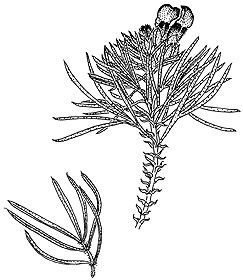
Description: Small shrubs or perennial herbs; conspicuously gland-dotted.
Leaves alternate, mostly 3-foliolate with terminal leaflet largest, sometimes pinnately or palmately 5–11-foliolate [or rarely 1-foliolate]; margins entire or toothed; long-petiolate, stipulate.
Inflorescences axillary racemes, mostly long-pedunculate; bracts membranous, caducous, each with 1–3 flowers in its axil. Calyx teeth ± equal, or lower one largest, or the upper two united, persistent in fruit. Standard ovate to circular; wings slightly adhering to the keel; keel obtuse, incurved and shorter than the wings. Stamens diadelphous; anthers uniform. Ovary sessile or stipitate; ovule 1.
Pod ovoid to obovoid, sometimes reniform, indehiscent and adhering to the seed; seed 1, without obvious aril.
Distribution and occurrence: World: c. 150 species, cosmopolitan mainly in tropical & temperate regions, especially southern Africa. Australia: 18 species (2 species introduced), all States.
Text by E. H. Norris & G. J. Harden
Taxon concept:
| | Key to the species | |
| 1 | Leaflets pubescent on both surfaces; flowers hidden within leaves, pale mauve to light blue, scentless or faintly scented; pedicels 2–5 mm long terminating in a trifid cupulate bract | Psoralea pinnata |
| Leaflets glabrescent above, wispily hairy below; flowers exerted beyond leaves, deep blue to purple, strongly sweet scented; pedicels 11–35 mm long terminating in a bifid cupulate bract | Psoralea arborea |
|


